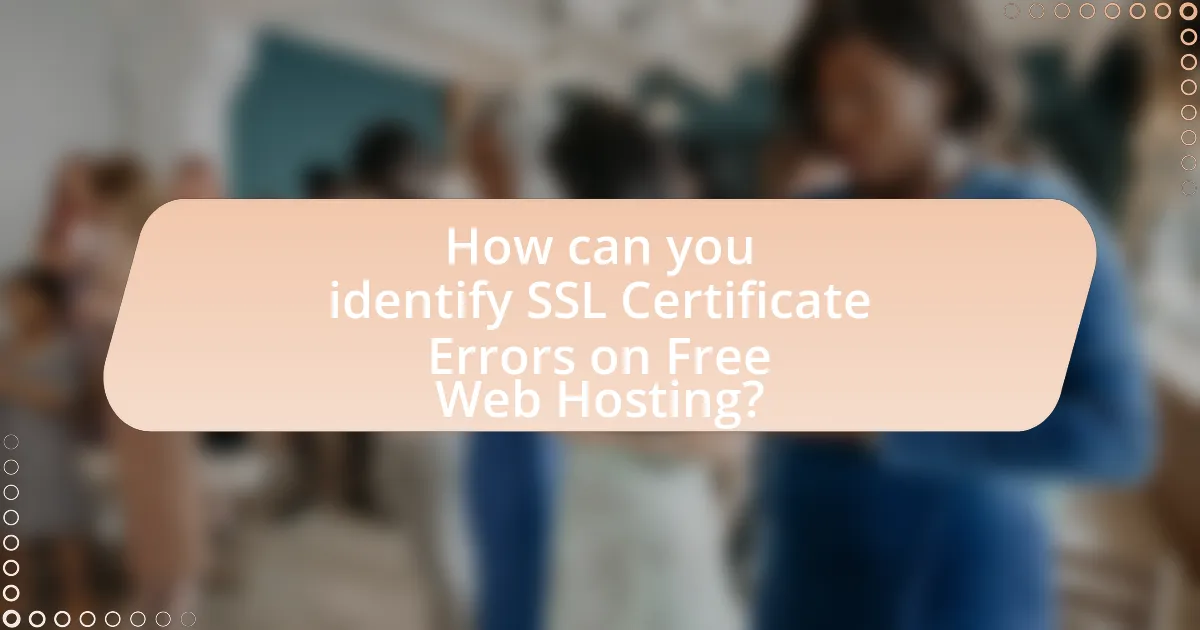SSL certificate errors on free web hosting arise when a website’s SSL certificate is invalid, expired, or improperly configured, leading to warnings in web browsers that indicate the site is not secure. Common types of errors include “Certificate Not Trusted,” “Certificate Expired,” and “Hostname Mismatch,” which can significantly impact user trust and website performance. The article outlines the causes of these errors, their implications for security and user experience, and provides practical steps for identifying and resolving SSL certificate issues. Additionally, it discusses tools and best practices for maintaining SSL certificates to prevent future errors, emphasizing the importance of secure connections in online environments.

What are SSL Certificate Errors on Free Web Hosting?
SSL certificate errors on free web hosting occur when a website’s SSL certificate is either invalid, expired, or improperly configured. These errors can prevent secure connections, leading to warnings in web browsers that indicate the site is not secure. Common causes include the use of self-signed certificates, which are not trusted by browsers, and the lack of proper domain validation, which is often a limitation of free hosting services. According to a study by the Internet Security Research Group, over 70% of free hosting providers do not offer valid SSL certificates, contributing to these errors.
How do SSL Certificate Errors manifest on websites?
SSL certificate errors manifest on websites primarily through warning messages displayed in web browsers, indicating that the connection is not secure. These errors can appear as “Your connection is not private,” “This site is not secure,” or “Certificate expired,” among others. Such messages occur when the SSL certificate is invalid, expired, or not trusted by the browser. For instance, according to a report by GlobalSign, 70% of users abandon a website when they encounter SSL errors, highlighting the critical nature of these warnings in affecting user trust and website accessibility.
What are the common types of SSL Certificate Errors?
Common types of SSL Certificate Errors include “Certificate Not Trusted,” “Certificate Expired,” “Hostname Mismatch,” and “Revoked Certificate.” Each of these errors indicates a specific issue with the SSL certificate’s validity or configuration. For instance, “Certificate Not Trusted” occurs when the browser does not recognize the certificate authority that issued the SSL certificate, often due to a lack of proper installation or an untrusted issuer. “Certificate Expired” signifies that the SSL certificate has surpassed its validity period, requiring renewal. “Hostname Mismatch” happens when the domain name in the URL does not match the name on the SSL certificate, leading to security warnings. Lastly, a “Revoked Certificate” indicates that the certificate has been invalidated by the issuer before its expiration date, often due to security concerns. These errors can compromise website security and user trust, making it essential to address them promptly.
Why do SSL Certificate Errors occur on free web hosting?
SSL certificate errors occur on free web hosting primarily due to the lack of proper validation and configuration of SSL certificates. Free web hosting services often use shared SSL certificates, which may not match the domain name, leading to trust issues in browsers. Additionally, these services may not provide automatic renewal or timely updates for SSL certificates, resulting in expired certificates that trigger errors. According to a study by SSL Labs, many free hosting providers do not support the latest security protocols, further exacerbating the likelihood of SSL errors.
What impact do SSL Certificate Errors have on website performance?
SSL certificate errors negatively impact website performance by causing browsers to block access to the site or display warning messages. These errors can lead to increased bounce rates, as users are likely to leave a site that appears insecure. According to a study by Google, 85% of users will abandon a site if they encounter security warnings, which directly affects traffic and user engagement. Additionally, SSL errors can hinder search engine rankings, as search engines prioritize secure sites in their algorithms. Therefore, resolving SSL certificate errors is crucial for maintaining optimal website performance and user trust.
How do SSL Certificate Errors affect user trust?
SSL certificate errors significantly diminish user trust by signaling potential security risks. When users encounter these errors, they may perceive the website as untrustworthy or compromised, leading to hesitation in sharing personal information or completing transactions. Research indicates that 85% of users abandon a site after encountering security warnings, highlighting the direct correlation between SSL errors and user confidence. Consequently, maintaining valid SSL certificates is crucial for fostering a secure online environment and ensuring user trust.
What are the security implications of SSL Certificate Errors?
SSL certificate errors indicate potential security vulnerabilities, such as man-in-the-middle attacks, where an attacker could intercept and manipulate data between a user and a website. These errors can arise from expired, misconfigured, or untrusted certificates, leading users to distrust the website and potentially exposing sensitive information. According to a study by the Ponemon Institute, 60% of organizations experienced a data breach due to SSL certificate mismanagement, highlighting the critical need for proper SSL certificate maintenance to ensure secure communications.

How can you identify SSL Certificate Errors on Free Web Hosting?
You can identify SSL certificate errors on free web hosting by checking for common indicators such as browser warnings, certificate expiration messages, and mismatched domain names. Browsers like Chrome and Firefox display alerts when a site’s SSL certificate is invalid, expired, or does not match the domain, prompting users to proceed with caution. Additionally, using online tools like SSL Labs’ SSL Test can provide detailed reports on the certificate’s validity and configuration. These methods are effective in diagnosing SSL certificate issues, ensuring secure connections for users.
What tools can help diagnose SSL Certificate Errors?
Tools that can help diagnose SSL Certificate Errors include SSL Labs’ SSL Test, OpenSSL, and Qualys SSL Checker. SSL Labs’ SSL Test provides a comprehensive analysis of the SSL configuration and identifies potential issues, while OpenSSL allows users to check the certificate details and validate the SSL connection through command-line tools. Qualys SSL Checker offers a user-friendly interface to quickly assess the SSL certificate status and identify any errors. These tools are widely recognized for their effectiveness in diagnosing SSL certificate issues, making them reliable resources for troubleshooting.
How do browser developer tools assist in identifying SSL issues?
Browser developer tools assist in identifying SSL issues by providing detailed information about the security status of a website’s connection. These tools allow users to inspect the SSL certificate, view any error messages related to the certificate, and analyze the security protocols in use. For instance, the “Security” tab in Chrome’s developer tools displays the certificate’s validity, issuer, and expiration date, helping users pinpoint issues such as expired or misconfigured certificates. Additionally, the console may log specific SSL-related errors, such as mixed content warnings, which indicate that secure and non-secure resources are being loaded together. This functionality enables developers to quickly diagnose and address SSL problems, ensuring a secure browsing experience.
What online services can check SSL Certificate validity?
Online services that can check SSL Certificate validity include SSL Labs, Why No Padlock, and DigiCert’s SSL Installation Diagnostics Tool. SSL Labs provides a comprehensive analysis of SSL configurations and certificate validity, while Why No Padlock focuses on identifying mixed content issues and SSL certificate problems. DigiCert’s tool offers diagnostics for SSL installation and certificate validity checks. These services are widely recognized for their reliability and accuracy in assessing SSL certificates.
What are the signs of SSL Certificate Errors on your website?
Signs of SSL Certificate Errors on your website include browser warnings, such as “Your connection is not private,” which indicates that the SSL certificate is either expired, invalid, or not trusted. Additionally, users may see a red padlock icon or a strikethrough on the padlock in the address bar, signaling that the SSL certificate is not functioning correctly. These errors can also manifest as mixed content warnings, where secure and non-secure resources are being loaded on the same page, further compromising security.
How can you recognize SSL warnings in different browsers?
You can recognize SSL warnings in different browsers by observing specific visual indicators and messages that signal potential security issues. In Google Chrome, a red padlock icon with a line through it or a warning message stating “Your connection is not private” indicates an SSL problem. Mozilla Firefox displays a similar warning with a red padlock and the message “Warning: Potential Security Risk Ahead.” Microsoft Edge shows a red padlock icon and a message indicating that the site is not secure. Safari alerts users with a warning message stating “This connection is not private” alongside a broken padlock icon. These consistent visual cues across browsers help users identify SSL certificate errors effectively.
What messages indicate SSL Certificate issues to users?
Messages indicating SSL Certificate issues to users include “Your connection is not private,” “This site is not secure,” and “Certificate expired.” These messages arise when browsers detect problems with the SSL certificate, such as invalidity, expiration, or mismatched domain names. For instance, Google Chrome displays a “Not Secure” warning when the SSL certificate is not properly configured, while Firefox shows “Warning: Potential Security Risk Ahead” for similar issues. These alerts serve to protect users from potential security threats associated with unsecured connections.

What steps can you take to fix SSL Certificate Errors on Free Web Hosting?
To fix SSL Certificate Errors on Free Web Hosting, first ensure that the SSL certificate is properly installed. This involves checking the hosting provider’s control panel for SSL settings and confirming that the certificate is active. Next, verify that the domain name matches the SSL certificate; mismatches can lead to errors. Additionally, clear your browser cache and cookies, as outdated data can cause SSL warnings. If the issue persists, consider using an online SSL checker tool to diagnose specific problems with the certificate. Finally, if the free hosting service does not support SSL, consider upgrading to a plan that includes SSL support or switching to a different provider that offers free SSL certificates.
How do you renew or obtain an SSL Certificate?
To renew or obtain an SSL Certificate, you must first choose a Certificate Authority (CA) that issues SSL Certificates. After selecting a CA, you need to generate a Certificate Signing Request (CSR) from your web server, which includes your public key and domain information. Submit the CSR to the CA, and they will validate your identity and domain ownership. Once validated, the CA will issue the SSL Certificate, which you can then install on your web server. For renewal, the process is similar: generate a new CSR, submit it to the CA, and install the renewed certificate upon issuance. This process is essential for maintaining secure connections and is supported by industry standards established by organizations like the Internet Engineering Task Force (IETF).
What are the steps to generate a Certificate Signing Request (CSR)?
To generate a Certificate Signing Request (CSR), follow these steps: First, open your server’s control panel or terminal. Next, navigate to the SSL/TLS section or use OpenSSL commands if in a terminal. Then, create a private key, which is essential for the CSR. After that, generate the CSR by providing details such as your domain name, organization, and location. Finally, save the CSR and private key securely, as you will need them to obtain your SSL certificate. These steps are standard across various platforms and ensure that the CSR is correctly formatted for submission to a Certificate Authority.
How can you install an SSL Certificate on your free hosting provider?
To install an SSL Certificate on your free hosting provider, first, check if your hosting provider supports SSL installation. Many free hosting services offer a built-in option for SSL certificates, often through a control panel. If available, navigate to the SSL/TLS section in your hosting dashboard, select the domain you wish to secure, and follow the prompts to enable SSL.
If your provider does not offer a built-in SSL option, you can use a free SSL service like Let’s Encrypt. Generate a certificate through their website, then manually upload the certificate files to your hosting account using the file manager or FTP. After uploading, configure your domain settings to use the SSL certificate, ensuring that HTTPS is enforced.
This process is valid as many free hosting providers have integrated SSL support or allow third-party SSL certificates, making it accessible for users to secure their websites.
What configuration changes might resolve SSL Certificate Errors?
To resolve SSL Certificate Errors, ensure that the SSL certificate is correctly installed and configured on the server. This includes verifying that the certificate matches the domain name, is not expired, and is issued by a trusted Certificate Authority. Additionally, check the server configuration to ensure that the correct intermediate certificates are included, as missing intermediates can lead to trust issues. Properly configuring the server to support the latest TLS protocols can also mitigate errors, as outdated protocols may cause compatibility issues with modern browsers.
How do you update your website’s configuration files for SSL?
To update your website’s configuration files for SSL, you need to modify the server settings to enable HTTPS. This typically involves editing the configuration file, such as the Apache .htaccess file or the Nginx configuration file, to redirect HTTP traffic to HTTPS and specify the SSL certificate paths. For example, in Apache, you would add the lines “RewriteEngine On” and “RewriteCond %{HTTPS} off” followed by “RewriteRule ^ https://%{HTTPHOST}%{REQUESTURI} [L,R=301]” to enforce HTTPS. In Nginx, you would include “server { listen 80; servername yourdomain.com; return 301 https://$host$requesturi; }” to achieve the same effect. These changes ensure that all traffic is securely encrypted, complying with SSL requirements.
What role does the .htaccess file play in SSL configuration?
The .htaccess file plays a crucial role in SSL configuration by enabling the enforcement of HTTPS on a website. This file allows webmasters to redirect all HTTP traffic to HTTPS, ensuring that all data transmitted between the server and the client is encrypted. By adding specific rewrite rules in the .htaccess file, such as “RewriteEngine On” and “RewriteCond %{HTTPS} off” followed by “RewriteRule ^ https://%{HTTPHOST}%{REQUESTURI} [L,R=301]”, webmasters can effectively redirect users to the secure version of their site. This method is widely used because it provides a simple and effective way to enhance security without requiring extensive server configuration changes.
What troubleshooting techniques can help resolve persistent SSL issues?
To resolve persistent SSL issues, one effective troubleshooting technique is to check the SSL certificate’s validity and configuration. This involves verifying that the certificate is not expired, correctly installed, and matches the domain name. Tools like SSL Labs’ SSL Test can provide detailed reports on certificate issues, including chain of trust and configuration errors. Additionally, clearing the browser cache and checking for mixed content errors can help, as these can prevent proper SSL functioning. Regularly updating server software and ensuring that the server supports the latest TLS versions also contributes to resolving SSL issues effectively.
How can you clear browser cache to fix SSL errors?
To clear browser cache and fix SSL errors, access your browser settings and locate the option for clearing browsing data. Select the cache and cookies options, then confirm the action to remove stored data. This process helps eliminate outdated or corrupted files that may interfere with SSL certificate validation, thereby resolving potential errors. For instance, Google Chrome allows users to clear cache by navigating to Settings > Privacy and Security > Clear Browsing Data, ensuring that the cached files are removed effectively.
What should you check if SSL errors persist after installation?
If SSL errors persist after installation, you should check the SSL certificate’s validity and configuration. Ensure that the certificate is not expired, correctly installed, and matches the domain name. Additionally, verify that the server is configured to use the correct certificate and that there are no mixed content issues on the website, which can cause browsers to flag SSL errors. These checks are essential because an invalid or misconfigured SSL certificate can lead to persistent errors, impacting website security and user trust.
What best practices can help prevent SSL Certificate Errors in the future?
To prevent SSL certificate errors in the future, regularly monitor and renew SSL certificates before their expiration dates. Implementing automated renewal processes can significantly reduce the risk of oversight. Additionally, ensure that the certificate is issued by a trusted Certificate Authority (CA) and that the domain name matches the certificate to avoid mismatches. Regularly updating server software and configurations also helps maintain compatibility with current SSL standards, reducing potential errors. According to a study by the Internet Security Research Group, timely renewal and proper configuration can decrease SSL-related issues by over 70%.
How often should you check your SSL Certificate status?
You should check your SSL certificate status at least once a month. Regular monthly checks help ensure that the certificate is valid, not expired, and properly configured. According to industry best practices, monitoring SSL certificates frequently can prevent potential security issues and maintain trust with users.
What are the benefits of using a paid SSL Certificate over a free one?
Paid SSL certificates offer enhanced security features compared to free ones, including stronger encryption standards and better validation processes. Paid certificates typically provide a higher level of trust, as they undergo rigorous vetting by Certificate Authorities, which can include domain validation, organization validation, or extended validation. This vetting process ensures that the entity behind the website is legitimate, reducing the risk of phishing attacks. Additionally, paid SSL certificates often come with warranties and customer support, which can be crucial for businesses that rely on secure transactions. According to a study by GlobalSign, 84% of consumers abandon a purchase if they perceive a lack of trust in a website, highlighting the importance of using a trusted SSL certificate.